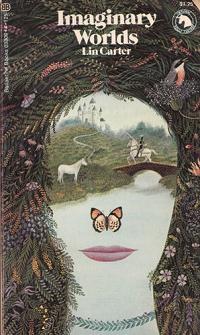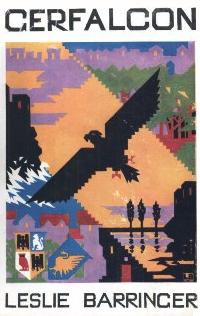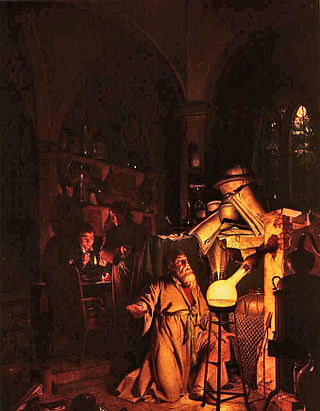
Sword and sorcery (S&S) or heroic fantasy is a subgenre of fantasy characterized by sword-wielding heroes engaged in exciting and violent adventures. Elements of romance, magic, and the supernatural are also often present. Unlike works of high fantasy, the tales, though dramatic, focus on personal battles rather than world-endangering matters. Sword and sorcery commonly overlaps with heroic fantasy. The genre originated from the early-1930s works of Robert E. Howard. The term "sword and sorcery" was coined by Fritz Leiber in the May 1961 issue of the fantasy fanzine Amra, to describe Howard and the stories that were influenced by his works. In parallel with "sword and sorcery", the term "heroic fantasy" is used, although it is a more loosely defined genre.

Damien Francis Broderick is an Australian science fiction and popular science writer and editor of some 74 books. His science fiction novel The Dreaming Dragons (1980) introduced the trope of the generation time machine, his The Judas Mandala (1982) contains the first appearance of the term "virtual reality" in science fiction, and his 1997 popular science book The Spike was the first to investigate the technological singularity in detail.

Linwood Vrooman Carter was an American author of science fiction and fantasy, as well as an editor, poet and critic. He usually wrote as Lin Carter; known pseudonyms include H. P. Lowcraft and Grail Undwin. He is best known for his work in the 1970s as editor of the Ballantine Adult Fantasy series, which introduced readers to many overlooked classics of the fantasy genre.

John Frederick Clute is a Canadian-born author and critic specializing in science fiction and fantasy literature who has lived in both England and the United States since 1969. He has been described as "an integral part of science fiction's history" and "perhaps the foremost reader-critic of science fiction in our time, and one of the best the genre has ever known." He was one of eight people who founded the English magazine Interzone in 1982.

Fantasy literature is literature set in an imaginary universe, often but not always without any locations, events, or people from the real world. Magic, the supernatural and magical creatures are common in many of these imaginary worlds. Fantasy literature may be directed at both children and adults.
Brian Attebery is an American writer and emeritus professor of English and philosophy at Idaho State University. He is known for his studies of fantasy literature, including The Fantasy Tradition in American Literature: From Irving to Le Guin (1980) and Strategies of Fantasy (1992) which won the Mythopoeic Award. Attebery is also editor of the Journal of the Fantastic in the Arts, for which he received the World Fantasy Award in 2021. He has also won the IAFA Award for distinguished scholarship and the Pilgrim Award for lifetime achievement.

Elements of the supernatural and the fantastic were an element of literature from its beginning. The modern genre is distinguished from tales and folklore which contain fantastic elements, first by the acknowledged fictitious nature of the work, and second by the naming of an author. Works in which the marvels were not necessarily believed, or only half-believed, such as the European romances of chivalry and the tales of the Arabian Nights, slowly evolved into works with such traits. Authors like George MacDonald (1824–1905) created the first explicitly fantastic works.

The Ballantine Adult Fantasy series was an imprint of American publisher Ballantine Books. Launched in 1969, the series reissued a number of works of fantasy literature which were out of print or dispersed in back issues of pulp magazines, in cheap paperback form—including works by authors such as James Branch Cabell, Lord Dunsany, Ernest Bramah, Hope Mirrlees, and William Morris. The series lasted until 1974.

The Newcastle Forgotten Fantasy Library was a series of trade paperback books published in the United States by the Newcastle Publishing Company between 1973 and 1980. Presumably under the inspiration of the earlier example set by the Ballantine Adult Fantasy series, the series reissued a number of works of fantasy literature that had largely been forgotten, being out of print or otherwise not easily available in the United States, in durable, illustrated trade paperback form with new introductions. For a number of works the Library’s editions constituted the first U.S. or first paperback edition. Together with the earlier series from Ballantine Books, it contributed to the renaissance of interest in the fantasy genre of the 1970s.
Leslie Barringer (1895–1968) was an English editor and author of historical novels and historical fantasy novels, best known for the latter.

Mythago Wood is a fantasy novel by British writer Robert Holdstock, published in the United Kingdom in 1984. Mythago Wood is set in Herefordshire, England, in and around a stand of ancient woodland, known as Ryhope Wood. The story involves the internally estranged members of the Huxley family, particularly Stephen Huxley, and his experiences with the enigmatic forest and its magical inhabitants. The conception began as a short story written for the 1979 Milford Writer's Workshop; a novella of the same name appeared in the September 1981 edition of The Magazine of Fantasy & Science Fiction.

Joris of the Rock is a fantasy novel by Leslie Barringer, the second book in his three volume Neustrian Cycle. The book was first published in the United Kingdom by Heinemann in 1928; an American edition followed from Doubleday in 1929. Its significance was recognized by its republication by the Newcastle Publishing Company as the ninth volume of the celebrated Newcastle Forgotten Fantasy Library series in September, 1976. The Newcastle edition was reprinted by Borgo Press in 1980 and 2010.

Gerfalcon is a fantasy novel by Leslie Barringer, the first book in his three volume Neustrian Cycle. The book was first published in 1927 by Heinemann in the United Kingdom and Doubleday in the United States. Its significance was recognized by its republication in 1973 by Tom Stacey in the UK and in March, 1976 by the Newcastle Publishing Company in the US, as the seventh volume of its celebrated Newcastle Forgotten Fantasy Library series. This Newcastle edition was reprinted twice, once by Newcastle itself in 1977 and once by Borgo Press in 1980.

The Face in the Frost is a short fantasy novel by American author John Bellairs published in 1969. Unlike most of his later works, this book is meant for adult readers. It centers on two accomplished wizards, Prospero and Roger Bacon, tracking down the source of a great magical evil. The subject matter prompted Ursula K. Le Guin to say of the novel, "The Face in the Frost takes us into pure nightmare before we know it—and out the other side."

Elements of the supernatural and the fantastic were an element of literature from its beginning, though the idea of a distinct genre, in the modern sense, is less than two centuries old.

The Shaving of Shagpat: An Arabian Entertainment is a fantasy novel by English writer George Meredith. It was first published in hardcover by Chapman and Hall in 1856, and there have been numerous editions since. Its importance in the history of fantasy literature was recognized by its reissuing by Ballantine Books as the seventeenth volume of the Ballantine Adult Fantasy series in July 1970. The Ballantine edition includes an introduction by Lin Carter.

When the Birds Fly South is a lost race fantasy novel by American writer Stanton A. Coblentz, defined as a "significant tale ... involving avian theriomorphy." It was first published in hardcover by The Wings Press, Mill Valley, California in 1945 and reprinted in 1951. Its importance in the history of fantasy literature was recognized by its republication by the Newcastle Publishing Company as the twenty-third volume of the Newcastle Forgotten Fantasy Library in April, 1980. The Newcastle edition was the first paperback edition, and had a new introduction by the author. Later editions were issued by Arno Press (1978) and Borgo Press (1980).

Aladore is a classic allegorical fantasy novel written by English poet Henry Newbolt. It was first published in hardcover by William Blackwood and Sons, Edinburgh, in 1914. An American edition from E. P. Dutton & Company, followed in 1915. The first paperback edition was issued by the Newcastle Publishing Company as the fifth volume of the Newcastle Forgotten Fantasy Library in September, 1975; this edition was reissued by Borgo Press in 1980. The book has been translated into German.

Renegade of Callisto is a science fantasy novel by American writer Lin Carter, the eighth and last in his Callisto series. It was first published in paperback by Dell Books in August 1978, and reprinted once, in November of the same year. A tribute to Edgar Rice Burroughs's The Chessmen of Mars, the book introduces the game of Darza, Carter's equivalent of Jetan. An appendix details the rules.
Bibliography of science fiction, fantasy, and nonfiction writer Lin Carter:
















